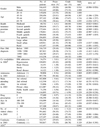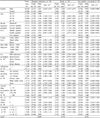1. International Diabetes Federation. Diabetes Atlas. 2003. 2nd ed.
2. Stratton IM, Adler AI, Neil HA, Matthews DR, Manley SE, Cull CA, Hadden D, Turner RC, Holman RR. Association of glycaemia with macrovascular and microvascular complications of type 2 diabetes (UKPDS 35): prospective observational study. BMJ. 2000. 321:405–412.
3. Vijan S, Stevens DI, Herman WH, Funnel MN, Stanford CJ. Screeing, preventing, counseling, and treatment for the complications of type II diabetes mellitus: putting evidence into practice. J Gen Intern Med. 1997. 12:567–580.
4. The Diabetes Control and Complications Trial Research Group. The effect of intensive treatment of diabetes on the development and progression of long-term complications in insulin-dependent diabetes mellitus. N Engl J Med. 1993. 329:977–986.
5. UK Prospective Diabetes Study (UKPDS) Group. Intensive blood-glucose control with sulphonylureas or insulin compared with conventional treatment and risk of complications in patients with type 2 diabetes (UKPDS 33). Lancet. 1998. 352:837–853.
6. Chodosh J, Morton SC, Mojica W, Maglione M, Suttorp MJ, Hilton L, Rhodes S, Shekelle P. Meta-analysis: Chronic disease self-management programs for older adults. Ann Intern Med. 2005. 143:427–438.
7. American Diabetes Association. Standards of medical care for patients with diabetes mellitus. Diabetes Care. 2001. 24:S33–S43.
9. Epping-Jordan JE, Pruitt SD, Bengoa R, Wagner EH. Improving the quality of health care for chronic conditions, Qual Saf Healt. Care. 2004. 13:299–305.
10. Ibrahim MA, Saviz LA, Carey TS, Wagner EH. Population-based health principles in medical and public health practice. Journal of Public Health Management and Practice. 2001. 7:75–81.
11. Norris SL, Glasgow RE, Engelgau MM, O'Connor PJ, McCulloch D. Chronic Disease Management -A Definition and Systematic Approach To Component Interventions. Dis Manage Health Outcomes. 2003. 11:477–488.
12. Glasgow RE, Funnell MM, Bonomi AE, Davis C, Beckham V, Wagner EH. Self-management aspects of the improving chronic illness care breakthrough series: implementation with diabetics and heart failure teams. Ann Behav Med. 2002. 27:80–87.
13. WHO Noncommunicable Disease and Mental Health. Innovative care for chronic conditions: building blocks for action: global report. 2002. WHO.
14. Desai J, Geiss L, Mukhtar Q, Harwell T, Benjamin S, Bell R, Tierney E. Public health surveillance of diabetes in United States. Journal of Public Health Management and Practice. 2003. Suppl. S44–S51.
16. National Quality Forum. Pay-for-performance programs: Guiding principles and design strategies-Conference proceedings. 2005.
17. Darden PM, Ector W, Moran C, Quattlebaum TG. Comparison of continuity in resident versus private practice. Pediatrics. 2001. 108:1263–1268.
21. Starfield B. Longitudinality and Managed Care. Primary Care: Concepts, Evaluation, and Policy. 1992. New York: Oxford University Press. Inc;41–55.
22. Center for Chronic Disease Prevention and Control. Diabetes in Canada. 2002. Health Canada.
23. American Diabetes Association. Standards of Medical Care in Diabetes. Diabetes Care. 2004. 27:S15–S35.






 PDF
PDF ePub
ePub Citation
Citation Print
Print









 XML Download
XML Download